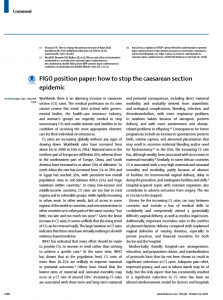
Worldwide there is an alarming increase in caesarean section (CS) rates. The medical profession on its own cannot reverse this trend. Joint actions with governmental bodies, the health-care insurance industry, and women’s groups are urgently needed to stop unnecessary CSs and enable women and families to be confident of receiving the most appropriate obstetric care for their individual circumstances.
With this FIGO position paper, we ask for the help of governmental bodies, UN partners, professional organisations, women’s groups, and other stakeholders to reduce unnecessary CSs:
1. The delivery fees for physicians for undertaking CS and attending vaginal delivery should be the same, using a mean fee. This should also happen in private practice settings.
2. Hospitals should be obliged to publish annual CS rates, and financing of hospitals should be partly based on CS rates. Risk-adjusted CS rates should become available.
3. Hospitals should use a uniform classification system for CSs (Robson/WHO classification).
4. Women should be informed properly on the benefits and risks of a CS.
5. Money that will become available from lowering CS costs should be invested in resources, better preparation for labour and delivery and better care, adequate pain relief, practical skills training for doctors and midwives, and reintroduction of vaginal instrumental deliveries to reduce the need for CS in the second stage of labour.
6. The situation in very low-income countries requires specific attention, considering that access to CSs is still insufficient in rural areas, whereas CSs seem to rise inappropriately in some urban areas and can be associated with substantial maternal morbidity and mortality. Both situations are unwanted. In rural areas, adequate access to skilled care, to appropriate fetal surveillance, and to assisted births or operative delivery is essential.
—
Caesarean section—the most common surgery in many countries around the world—is a procedure that can save women’s and babies’ lives when complications occur during pregnancy or birth. However, caesarean section use for non-medically indicated reasons is a cause for concern because the procedure is associated with considerable short-term and long-term effects and health-care costs. Caesarean section use has increased over the past 30 years in excess of the 10–15% of births considered optimal, and without significant maternal or perinatal benefits. A three-part Lancet Series on Optimising Caesarean Section Use reviews the global epidemiology and disparities in caesarean section use, as well as the health effects for women and children, and lays out evidence-based interventions and actions to reduce unnecessary caesarean sections.
Access the 1st paper of the Lancet series – Global epidemiology of use of and disparities in caesarean sections
Access the 2nd paper of the Lancet Series – Short-term and long-term effects of caesarean section on the health of women and children
Access the 3rd paper of the Lancet Series – Interventions to reduce unnecessary caesarean sections in healthy women and babies
Access the 2nd Comments paper about the series – Appropriate use of caesarean section globally requires a different approach
Access the 3rd Comments paper about the series – Strategic measures to reduce the caesarean section rate in Brazil
Access the Editorial paper about the series – Stemming the global caesarean section epidemic
Access the Profile paper related to the series – Ana Pilar Betrán: seeking the optimum use of caesarean section